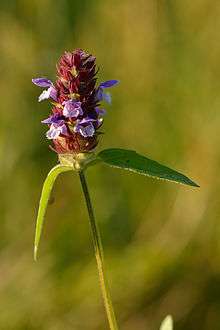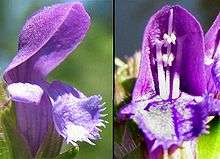Prunella vulgaris
Prunella vulgaris (known as common self-heal, heal-all, woundwort, heart-of-the-earth, carpenter's herb, brownwort and blue curls)[1][2][3] is a herbaceous plant in the genus Prunella.
| Prunella vulgaris | |
|---|---|
 | |
| Scientific classification | |
| Kingdom: | Plantae |
| Clade: | Tracheophytes |
| Clade: | Angiosperms |
| Clade: | Eudicots |
| Clade: | Asterids |
| Order: | Lamiales |
| Family: | Lamiaceae |
| Genus: | Prunella |
| Species: | P. vulgaris |
| Binomial name | |
| Prunella vulgaris | |
Self-heal is edible: the young leaves and stems can be eaten raw in salads; the plant in whole can be boiled and eaten as a potherb; and the aerial parts of the plant can be powdered and brewed in a cold infusion to make a beverage.
Description

Prunella vulgaris grows 5 to 30 cm high[4] (2-12inches), with creeping, self-rooting, tough, square, reddish stems branching at leaf axis.[5]
The leaves are lance shaped, serrated and reddish at the tip, about 2.5 cm (1 inch) long and 1.5 cm (half an inch) broad, and growing in opposite pairs down the square stem.[5] Each leaf has 3-7 veins that shoot off the middle vein to the margin. The stalks of the leaves are generally short, but can be up to 5 cm (2 inches) long.[6]
The flowers grow from a clublike, somewhat square, whirled cluster; immediately below this club is a pair of stalkless leaves standing out on either side like a collar. Flowers are two lipped and tubular. The top lip is a purple hood, and the bottom lip is often white; it has three lobes, with the middle lobe being larger and fringed upwardly. Flowers bloom at different times depending on climate and other conditions, but mostly in summer (from June to August in the USA).[5]
Self-heal propagates both by seed and vegetatively by creeping stems that root at the nodes.[7]
Range
Heal-all is a perennial herb found throughout Europe, Asia and North America, as well as most temperate climates. In Ireland it is generally abundant.[8][9]
Habitat
Roadsides, gardens and waste-places.[8] Woodland edges, and usually in basic and neutral soils.[5][10]
Edibility
Heal-all is edible, and can be used in salads, soups, stews, and boiled as a pot herb. The Cherokee cooked and ate the young leaves. The Nlaka'pamux drank a cold infusion of the whole plant as a common beverage.[11] The plant contains vitamins A, C, and K, as well as flavonoids and rutin.[12]
Folk medicine
The plant is considered by the Chinese to "change the course of a chronic disease".[11]
Self heal is commonly used for sore throats and halitosis.[13] It is one of the main ingredients of popular commercial Chinese herbal tea, like that of Wang Lao Ji (Chinese: 王老吉; in Cantonese: Wong Lo Kat).
Chemistry
The plant's chemical constituents include betulinic acid, D-camphor, D-fenchone, cyanidin, delphinidin, hyperoside, manganese, lauric acid, oleanolic acid, rosmarinic acid, myristic acid, rutin, linoleic acid, ursolic acid, beta-sitosterol, lupeol, and tannins.[12][14]
Etymology
Prunella is derived from 'Brunella', a word which is itself a derivative, taken from "die Bräune", the German name for quinsy (a type of throat inflammation), which it was historically used to cure.[15]
Vulgaris means 'usual', 'common', or 'vulgar'.[15]
References
| Wikimedia Commons has media related to Prunella vulgaris. |
| Wikispecies has information related to Prunella vulgaris |
- Gray, Samuel F. (1821). Natural Arrangement of British Plants: According to Their Relations to Each Other, as Pointed Out by Jussieu, De Candolle, Brown &c... vol 2. Baldwin, Cradock and Joy. p. 389.
- Lust, John (2014). The Herb Book: The Most Complete Catalog of Herbs Ever Published (Dover republication ed.). USA: Courier Corporation. p. 399. ISBN 9780486794785.
- Fisher, Robert (1932). The English Names of Our Commonest Wild Flowers ... T. Buncle & Company. p. 195.
- Clapham, A.R., Tutin, T.G. and Warburg, E.F. 1968. p. 347. Excursion Flora of the British Isles. Cambridge University Press. ISBN 0-521-04656-4
- "Conservation Plant Characteristics for Prunella vulgaris L. (common selfheal)". Plants Database. United States Department of Agriculture.
- Duke, James (2001). "Prunella vulgaris". Handbook of Edible Weeds. CRC. p. 158. ISBN 978-0-8493-2946-3.
- DiTomaso, Joseph M.; Healy, Evelyn A. (2007). Weeds of California and Other Western States, Volume 1. ANR. p. 884. ISBN 978-1-879906-69-3.
- Parnell, J. and Curtis, T. 2012. Webb's An Irish Flora. Cork University Press. ISBN 978-185918-4783
- Scannell, M.P. and Synnott, D.M. 1972 Census Catalogue of the Flora of Ireland. Dublin Stationery Office
- Foster, Steven; Hobbs, Christopher (2002). "Self-heal, Heal-All". A Field Guide to Western Medicinal Plants and Herbs. Houghton Mifflin Harcourt. p. 231. ISBN 978-0-395-83806-8.
- Meuninck, Jim (2008). Medicinal Plants of North America: A Field Guide. Globe Pequot. p. 41. ISBN 978-0-7627-4298-1.
- Khare, C.P. (2007). Indian Medicinal Plants: An Illustrated Dictionary. Springer. p. 103. ISBN 978-0-387-70637-5.
- https://patents.google.com/patent/CN105613880A/en
- Duke, James A.; Beckstrom-Sternberg, Stephen M. (2001). Handbook of Medicinal Mints (Aromathematics): Phytochemicals and Biological Activities. CRC. p. 222. ISBN 978-0-8493-2724-7.
- Gledhill, David (2008). "The Names of Plants". Cambridge University Press. ISBN 9780521866453 (hardback), ISBN 9780521685535 (paperback). pp 316, 404